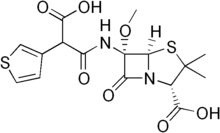Temocillin: Difference between revisions
| Line 49: | Line 49: | ||
It is normally active against ''[[Moraxella catarrhalis]]'', ''[[Brucella abortus]]'', ''[[Burkholderia cepacia]]'', ''[[Citrobacter]]'' species, ''[[Escherichia coli]]'', ''[[Haemophilus influenzae]]'', ''[[Klebsiella pneumoniae]]'', ''[[Pasteurella multocida]]'', ''[[Proteus mirabilis]]'', ''[[Salmonella typhimurium]]'' and ''[[Yersinia enterocolitica]]''. It is also active against some ''[[Enterobacter]]'' species, ''[[Morganella morganii]]'', and ''[[Serratia]]'' species. Temocillin has no useful activity against [[Gram positive]] organisms, ''[[Acinetobacter]]'' species, or ''[[Pseudomonas aeruginosa]]''. |
It is normally active against ''[[Moraxella catarrhalis]]'', ''[[Brucella abortus]]'', ''[[Burkholderia cepacia]]'', ''[[Citrobacter]]'' species, ''[[Escherichia coli]]'', ''[[Haemophilus influenzae]]'', ''[[Klebsiella pneumoniae]]'', ''[[Pasteurella multocida]]'', ''[[Proteus mirabilis]]'', ''[[Salmonella typhimurium]]'' and ''[[Yersinia enterocolitica]]''. It is also active against some ''[[Enterobacter]]'' species, ''[[Morganella morganii]]'', and ''[[Serratia]]'' species. Temocillin has no useful activity against [[Gram positive]] organisms, ''[[Acinetobacter]]'' species, or ''[[Pseudomonas aeruginosa]]''. |
||
Its primary use is against [[Enterobacteriaceae]], and in particular against strains producing [[extended spectrum beta- |
Its primary use is against [[Enterobacteriaceae]], and in particular against strains producing [[extended spectrum beta-lactamase|extended spectrum β-lactamase]] or [[AmpC]] [[beta-lactamase|β-lactamase]].<ref>Livermore DM ''et al.'' (2006) Activity of temocillin vs. prevalent ESBL- and AmpC-producing Enterobacteriaceae from SE England. J Antimicrob Chemother. 2006 May;57(5):1012-4</ref> |
||
==Dosage== |
==Dosage== |
||
Revision as of 08:17, 6 July 2011
 | |
| Clinical data | |
|---|---|
| ATC code | |
| Identifiers | |
| |
| CAS Number | |
| PubChem CID | |
| ChemSpider | |
| UNII | |
| KEGG | |
| CompTox Dashboard (EPA) | |
| ECHA InfoCard | 100.060.148 |
| Chemical and physical data | |
| 3D model (JSmol) | |
| |
| |
| | |
Temocillin is a β-lactamase resistant penicillin[1][2] introduced by Beecham, marketed by Eumedica Pharmaceuticals as Negaban primarily for the treatment of multiresistant Gram negative bacteria.
It is a carboxypenicillin.[3]
Pharmacology
Temocillin is a β-lactamase resistant penicillin. It is not active against Gram positive bacteria or bacteria with altered penicillin-binding proteins.
It is normally active against Moraxella catarrhalis, Brucella abortus, Burkholderia cepacia, Citrobacter species, Escherichia coli, Haemophilus influenzae, Klebsiella pneumoniae, Pasteurella multocida, Proteus mirabilis, Salmonella typhimurium and Yersinia enterocolitica. It is also active against some Enterobacter species, Morganella morganii, and Serratia species. Temocillin has no useful activity against Gram positive organisms, Acinetobacter species, or Pseudomonas aeruginosa.
Its primary use is against Enterobacteriaceae, and in particular against strains producing extended spectrum β-lactamase or AmpC β-lactamase.[4]
Dosage
The common dosage is 2g intravenously every 12 hours. There are good theoretical reasons for giving Temocillin as a continuous intravenous infusion in severe disease:[5] a single loading dose of 2g is given intravenously followed by a 4g infusion over 24 hours. Temocillin for intravenous injection is diluted in 20ml of sterile water; it is diluted in less than 2.7ml of sterile water when being prepared for intramuscular injection; the continuous infusion is diluted in 48ml of sterile water for ease of administration (1ml per half hour). To reduce pain, the intramuscular injection may be made up using sterile 1% lignocaine instead of sterile water.
Temocillin may be given to patients with impaired renal function. No adjustment needs to be made to the dose in mild to moderate renal impairment (creatinine clearance greater than 30ml/min). The manufacturer does not recommend using reduced doses, instead they recommend increasing the duration between doses. In severe renal impairment when it is 10 to 30, the dose is 1g in 24 hours; when less than 10, the dose is 1g every 48 hours. Temocillin is cleared by haemodialysis, which means that in dialysis patients, the dose should be given after dialysis.
There is no licensed oral preparation of temocillin.
Adverse effects
The undesirable effects of temocillin are those of any β-lactam antibiotic. In particular, Temocillin has been associated with angioedema and anaphylaxis in penicillin allergic patients. Animal studies have not shown any induction of Clostridium difficile infection.[6] As with any other penicillin, convulsions can occur if very high doses are given.
References
- ^ Andrews JM, Jevons G, Walker R, Ashby J, Fraise AP (2007). "Temocillin susceptibility by BSAC methodology". J. Antimicrob. Chemother. 60 (1): 185–7. doi:10.1093/jac/dkm179. PMID 17550891.
{{cite journal}}: Unknown parameter|month=ignored (help)CS1 maint: multiple names: authors list (link) - ^ Van Landuyt HW, Pyckavet M, Lambert A, Boelaert J (1982). "In vitro activity of temocillin (BRL 17421), a novel beta-lactam antibiotic". Antimicrob. Agents Chemother. 22 (4): 535–40. PMC 183789. PMID 7181470.
{{cite journal}}: Unknown parameter|month=ignored (help)CS1 maint: multiple names: authors list (link) - ^ Chanal M, Sirot J, Cluzel M, Joly B, Glanddier Y (1983). "[In vitro study of the bacteriostatic and bactericidal activity of temocillin (BRL 17421)]". Pathol. Biol. (in French). 31 (6): 467–70. PMID 6348653.
{{cite journal}}: Unknown parameter|month=ignored (help)CS1 maint: multiple names: authors list (link) - ^ Livermore DM et al. (2006) Activity of temocillin vs. prevalent ESBL- and AmpC-producing Enterobacteriaceae from SE England. J Antimicrob Chemother. 2006 May;57(5):1012-4
- ^ De Jongh R et al. (2008) Continuous versus intermittent infusion of temocillin, a directed spectrum penicillin for intensive care patients with nosocomial pneumonia: stability, compatibility, population pharmacokinetic studies and breakpoint selection. J Antimicrob Chemother. 2008 Feb;61(2):382-8
- ^ Boon RJ; et al. (1985). "Studies with temocillin in a hamster model of antibiotic-associated colitis". Antimicrob Agents Chemother. 27 (6): 980–1. PMC 180203. PMID 3875312.
{{cite journal}}: Explicit use of et al. in:|author=(help)
Further reading
- Livermore DM, Tulkens PM (2009). "Temocillin revived". Journal of Antimicrobial Chemotherapy. 63 (2): 243–5. doi:10.1093/jac/dkn511. PMID 19095679.
{{cite journal}}: Unknown parameter|month=ignored (help)
